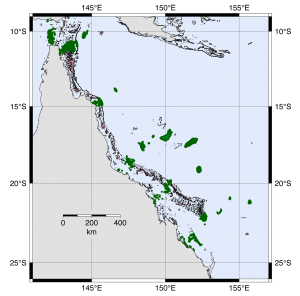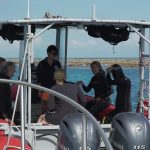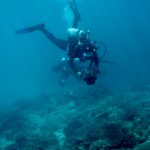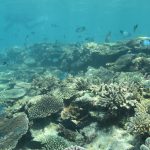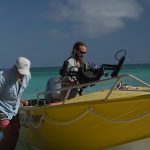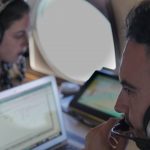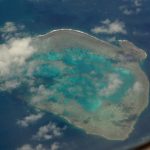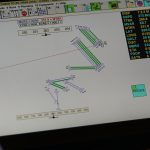After six weeks in Australia (Sept 1-Oct 16), NASA’s COral Reef Airborne Laboratory (CORAL) has completed its campaign along the world’s largest reef structure—the Great Barrier Reef. Eric Hochberg, BIOS reef scientist and CORAL Principle Investigator, says he’s pleased with the “successful conclusion to the first of four field campaigns designed to shed light on the condition and function of representative reef ecosystems around the world.”
To achieve this objective, CORAL is using a special instrument called PRISM (Portable Remote Imaging SpectroMeter) that was developed by NASA’s Jet Propulsion Laboratory (JPL) specifically to study coastal environments. Housed in a Tempus Applied Solutions Gulfstream-IV airplane, the PRISM instrument is operated during flight to measure light values, or spectra, of the seafloor that are used to signal the type and condition of the reef community. The result is a set of maps that accurately represent the relative densities of coral, algae and sand in each area, but also rates of primary productivity of calcification, both processes that are indicative of reef health.
Beginning on September 5, the flight team worked around local and regional weather patterns to cover six sectors that provide nearshore to offshore and north to south gradients of the Great Barrier Reef: Townsville, Mackay, Heron Island, Lizard Island, Torres Strait and NE Torres Strait.
During this time, three field teams were deployed to Lizard Island and Heron Island to make additional measurements of benthic cover (what the bottom habitat looks like), reef metabolism (photosynthesis and calcification) and water optics (the physical properties of the water column that influence how light travels from the surface to the bottom). Data from the field teams will be used to validate the airborne data collected by the PRISM instrument.
On September 9 and 17 the CORAL flight team was able to conduct flight lines over Lizard Island and Heron Island, respectively, allowing the in-water teams to make concurrent measurements. The water optics field team, led by Brandon Russell (University of Connecticut) and Rodrigo Garcia (University of Massachusetts Boston), was able to capture measurements that accurately reflect properties of the water column at the time of the flyover. These “match-ups” are valuable opportunities to obtain data from the air and water simultaneously, which is particularly important for conditions that can change rapidly, such as water chemistry and optics. See a matchup in action with this NASA Earth Expeditions v-log “Perfect timing for CORAL”:
A third “match-up” took place on October 6 in coordination with the Commonwealth Scientific and Industrial Research Organization (CSIRO) research vessel Investigator. While on a multi-project scientific cruise, CSIRO scientist Karen Wild-Allen was able to make in-water measurements of water optical properties during CORAL’s overflight process.
During the time on Lizard and Heron Islands the reef metabolism team, led by Bob Carpenter (California State University Northridge), studied a total of 20 sites (10 at each location) in the lagoon and outer reef that encompassed a variety of bottom types, including mixed coral, sand and algae habitats. Data from these sites will help CORAL scientists better understand how reef ecosystems uptake and recycle carbon.
The benthic cover team, led by Steve Dollar (University of Hawaii), surveyed 38 sites at Heron Island, in addition to the 36 sites previously surveyed at Lizard Island, resulting in thousands of high resolution photographs that will be stitched together by state-of-the-art computer software to produce larger-scale mosaics of reef habitat. Take a peek at the benthic team’s work in this NASA Earth Expeditions v-log “GPS in the water”:
Presently, the field teams have returned to their respective institutions and are in the process of collating and analyzing data collected during the Great Barrier Reef campaign. The flight team departed Cairns, Australia early Wednesday, October 19 and returned home to Maine by way of the Marshall Islands, Honolulu, Hawaii, and Burbank, California.
The CORAL team would like to extend thanks to its many supporters and collaborators who made this mission successful, including Hawker Pacific, CSIRO, the University of Queensland, the Great Barrier Reef Marine Park Authority, Daintree Air Services, Allstate Boat Licensing & Training, Lizard Island Research Station and Heron Island Research Station.
Preparations are now underway for the next campaign to the main Hawaiian islands. Hochberg says, “We accomplished and learned a lot during our time in Australia and we’re excited to see what the data from our 2017 field campaigns will show.” For continued updates on CORAL, including future campaigns in 2017 to the Main Hawaiian Islands, Guam and Palau, visit us on Facebook (@coralreefairbornelaboratory) and online at www.coral.bios.edu and www.coral.jpl.nasa.gov.
The CORAL Flight Locator Tool can be used to track CORAL flights and access CORAL data. CORAL has unfunded collaborators in Australia who are advising on, and conducting parallel in-water validation for, the Great Barrier Reef campaign:
Photo Gallery
- CORAL team members prepare for in-water validation activities
- Steve Dollar prepares to enter the water
- A diver takes high resolution photos for benthic habitat assessment
- Researchers survey an area of reef on Heron Island
- Researchers install gradient flux instruments at a survey site
- The optics team prepares gear for deployment on Lizard Island
- Members of the CORAL flight team communicate to the pilot during a mission
- An aerial view of a portion of the Great Barrier Reef
- A view of the flight tracker aboard the G4 airplane during a CORAL mission
NASA Earth Blog #10
Taking the Pulse of the Reef: “It’s Algalicious” NASA EARTH·TUESDAY, SEPTEMBER 27, 2016 Bob Carpenter surveys the seafloor surrounding the research vessel Anthias as it glides over Blue Lagoon, the largest part of the reef that envelops Heron Island. He and his team,...
NASA Earth Blog #9
Heron Island: Like Nowhere Else on Earth Heron Island is a 42-acre coral cay located within the World Heritage-listed Great Barrier Reef Marine Park, 45 miles (72 kilometers) off the coast of Queensland, Australia. It is surrounded by a 5-mile-long...
NASA Earth Blog #8
Coral Reef Close-up: CORAL Goes Down Under Down Under NASA EARTH·FRIDAY, SEPTEMBER 23, 2016 It’s a warm and sunny morning in mid-September as Stacy Peltier and her colleagues on NASA’s Coral Reef Airborne Laboratory (CORAL) mission survey team prepare for their first...
NASA Earth Blog #7
NASA’s CORAL Mission Journeys to Oz NASA EARTH·TUESDAY, SEPTEMBER 13, 2016 G’day from Australia! With the successful June campaign readiness tests in Hawaii behind them, NASA’s Coral Reef Airborne Laboratory (CORAL) team has rolled up their sleeves and are now hard at...


